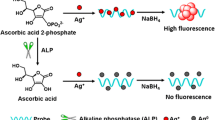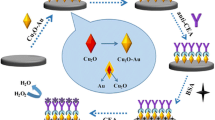Abstract
An ultrasensitive liquid crystal biosensor is described for multicolor visualization of the activity of alkaline phosphatase (ALP) based on the controlled growth of silver nanoparticles. The enzymatic product is accumulated on the surface of the LC sensing film by means of silver deposition, and the birefringent signal (observed with a polarizing microscope) is strongly enhanced as a result. The presence of AuNPs also enhances the sensitivity by about 4 orders of magnitude. The bright spots in polarized optical microscopy (POM) images increase with increasing activities of ALP. The signal intensities of the spots are then calculated by using Photoshop software and by multiplying the average brightness of the spots by the pixel value. The detection limit for ALP is 1.2 nU·mL−1, which is 5–7 orders of magnitude lower than other colorimetric or fluorometric methods. The method was applied to a highly sensitive immunoassay for the carcinoembryonic antigen (CEA) by integrating immunomagnetic separation. The immunoassay was applied to the analysis of complex samples without tedious sample pretreatment, and a detection limit as low as 0.35 pg·mL−1 of CEA was achieved. The method has attractive features in that it provides an ultrasensitive multicolor visualization approach for enzymes such as ALP, but also paves the way to a new kind of immunoassay coupled to immunomagnetic separation.

A signal enhanced liquid crystal (LC)-based multicolor immunosensor is described that is based on immunomagnetic separation and biometallization. Alkaline phosphatase (ALP) and carcinoembryonic antigen (CEA) can be easily visualized by bare eyes using the polarized optical microscopy (POM) images of LCs.






Similar content being viewed by others
References
Shah RR, Abbott NL (2001) Principles for measurement of chemical exposure based on recognition-driven anchoring transitions in liquid crystals. Science 293:1296–1299
Clare BH, Abbott NL (2005) Orientations of nentatic liquid crystals on surfaces presenting controlled densities of peptides: amplification of protein-peptide binding events. Langmuir 21:6451–6461
Gupta VK, Skaife JJ, Dubrovsky TB, Abbott NL (1998) Optical amplification of ligand-receptor binding using liquid crystals. Science 279:2077–2080
Shen J, He F, Chen L, Ding L, Liu H, Wang Y, Xiong X (2017) Liquid crystal-based detection of DNA hybridization using surface immobilized single-stranded DNA. Microchim Acta 184(9):3137–3144
Chen CH, Lin YC, Chang HH, Lee ASY (2015) Ligand-doped liquid crystal sensor system for detecting mercuric ion in aqueous solutions. Anal Chem 87:4546–4551
Kim HJ, Rim J, Jang CH (2017) Liquid-crystal-based immunosensor for diagnosis of tuberculosis in clinical specimens. ACS Appl Mater Inter 9:21209–21215
Wang Y, Wang B, Shen J, Xiong X, Deng S (2017) Aptamer based bare eye detection of kanamycin by using a liquid crystal film on a glass support. Microchim Acta 184(10):3765–3771
Sivakumar S, Wark KL, Gupta JK, Abbott NL, Caruso F (2009) Liquid crystal emulsions as the basis of biological sensors for the optical detection of bacteria and viruses. Adv Funct Mater 19:2260–2265
Yang S, Liu Y, Tan H, Wu C, Wu Z, Shen G, Yu R (2012) Gold nanoparticle based signal enhancement liquid crystal biosensors for DNA hybridization assays. Chem Commun 48:2861–2863
Tan H, Yang S, Shen G, Yu R, Wu Z (2010) Signal-enhanced liquid-crystal DNA biosensors based on enzymatic metal deposition. Angew Chem Int Ed 49:8608–8611
Serafin V, Torrente-Rodriguez RM, Batlle M, Garcia de Frutos P, Campuzano S, Yanez-Sedeno P, Pingarron JM (2017) Comparative evaluation of the performance of electrochemical immunosensors using magnetic microparticles and nanoparticles. Application to the determination of tyrosine kinase receptor AXL. Microchim Acta 184(11):4251–4258
Zhou CH, Wu Z, Chen JJ, Xiong C, Chen Z, Pang DW, Zhang ZL (2015) Biometallization-based electrochemical magnetoimmunosensing strategy for avian influenza a (H7N9) virus particle detection. Chem Asian J 10:1387–1393
Zhou CH, Zhao JY, Pang DW, Zhang ZL (2014) Enzyme-induced metallization as a signal amplification strategy for highly sensitive colorimetric detection of avian influenza virus particles. Anal Chem 86:2752–2759
Liu X, Atwater M, Wang J, Huo Q (2007) Extinction coefficient of gold nanoparticles with different sizes and different capping ligands. Colloid surfaces B 58:3–7
Wang CH, Gao J, Cao YL, Tan HL (2018) Colorimetric logic gate for alkaline phosphatase based on copper (II)-based metal-organic frameworks with peroxidase-like activity. Anal Chim Acta 1004:74–81
Wei H, Chen C, Han B, Wang E (2008) Enzyme colorimetric assay using unmodified silver nanoparticles. Anal Chem 80:7051–7055
Shi D, Sun Y, Lin L, Shi C, Wang G, Zhang X (2016) Naked-eye sensitive detection of alkaline phosphatase (ALP) and pyrophosphate (PPi) based on a horseradish peroxidase catalytic colorimetric system with cu(ii). Analyst 141:5549–5554
Chen X, Chen J, Zhang HY, Wang FB, Wang FF, Ji XH, He ZK (2016) Colorimetric detection of alkaline phosphatase on microfluidic paper-based analysis devices. Chinese J Anal Chem 44:591–596
Li SJ, Li CY, Li YF, Fei J, Wu P, Yang B, Ou-Yang J, Nie SX (2017) Facile and sensitive near-infrared fluorescence probe for the detection of endogenous alkaline phosphatase activity in vivo. Anal Chem 89:6854–6860
Liu HW, Li K, Hu XX, Zhu LM, Rong QM, Liu YC, Zhang XB, Hasserodt J, Qu FL, Tan WH (2017) In situ localization of enzyme activity in live cells by a molecular probe releasing a precipitating fluorochrome. Angew Chem Int Edit 56:11788–11792
Hu LZ, Zhang Q, Gan XY, Lin SL, Han S, Zhang ZC (2018) Fluorometric turn-on determination of the activity of alkaline phosphatase by using WS2 quantum dots and enzymatic cleavage of ascorbic acid 2-phosphate. Microchim Acta 185(8):1–6
Hu Z, Chen J, Li Y, Wang Y, Zhang Q, Hussain E, Yang M, Shahzad SA, Yu D, Yu C (2017) Nucleic acid-controlled quantum dots aggregation: a label-free fluorescence turn-on strategy for alkaline phosphatase detection. Talanta 169:64–69
Xiang MH, Liu JW, Li N, Tang H, Yu RQ, Jiang JH (2016) A fluorescent graphitic carbon nitride nanosheet biosensor for highly sensitive, label-free detection of alkaline phosphatase. Nanoscale 8:4727–4732
Li X, Zhou CH, Zi QJ, Cao QE (2016) An electrochemical signal transduction amplification strategy for ultrasensitive detection of ascorbic acid. J Electroanal Chem 780:321–326
Hasanzadeh M, Shadjou N (2017) Advanced nanomaterials for use in electrochemical and optical immunoassays of carcinoembryonic antigen. A review. Microchim Acta 184(2):389–414
Luo C, Wen W, Lin F, Zhang X, Gu H, Wang S (2015) Simplified aptamer-based colorimetric method using unmodified gold nanoparticles for the detection of carcinoma embryonic antigen. RSC Adv 5:10994–10999
Ma X, Lin Y, Guo L, Qiu B, Chen G, Yang HH, Lin Z (2017) A universal multicolor immunosensor for semiquantitative visual detection of biomarkers with the naked eyes. Biosens Bioelectron 87:122–128
Wang X, Zhang B, Li J, Chang HH, Wei WL (2017) A simple and fast chromogenic reaction based on Ag3PO4/ag nanocomposite for tumor marker detection. Talanta 175:229–234
Wang YZ, Zhu GX, Qi WJ, Li Y, Song YJ (2016) A versatile quantitation platform based on platinum nanoparticles incorporated volumetric bar-chart chip for highly sensitive assays. Biosens Bioelectron 85:777–784
Xiao L, Zhu A, Xu Q, Chen Y, Xu J, Weng J (2017) Colorimetric biosensor for detection of cancer biomarker by au nanoparticle-decorated Bi2Se3 nanosheets. ACS Appl Mater Inter 9:6931–6940
Xu SH, Feng XY, Gao T, Liu GF, Mao YN, Lin JH, Yu XJ, Luo XL (2017) Aptamer induced multicoloured au NCs-MoS2 "switch on" fluorescence resonance energy transfer biosensor for dual color simultaneous detection of multiple tumor markers by single wavelength excitation. Anal Chim Acta 983:173–180
Acknowledgements
This work was supported by the National Natural Science Foundation of China (NSFC, 21505119, 21465025), Applied and Basic Research Program of Yunnan Province (NO. 2015FD002), the Yunnan University’s Research Innovation Fund for Graduate Student (NO. 2018Z068). The authors would also like to thank Prof. Xiao Hong Chen at Yunnan University for her kindly support on this research.
Author information
Authors and Affiliations
Corresponding authors
Ethics declarations
The author(s) declare that they have no competing interests.
Additional information
Publisher’s Note
Springer Nature remains neutral with regard to jurisdictional claims in published maps and institutional affiliations.
Electronic supplementary material
ESM 1
(DOCX 5.43 mb)
Rights and permissions
About this article
Cite this article
Zhou, CH., Zi, Qj., Wang, J. et al. Determination of alkaline phosphatase activity and of carcinoembryonic antigen by using a multicolor liquid crystal biosensor based on the controlled growth of silver nanoparticles. Microchim Acta 186, 25 (2019). https://doi.org/10.1007/s00604-018-3131-9
Received:
Accepted:
Published:
DOI: https://doi.org/10.1007/s00604-018-3131-9




